
Everglades National Park – sometimes known as ‘the Everglades’ – is the largest protected wetland area in the United States. Located in the southeastern state of Florida, the Everglades is one of the most biodiverse ecosystems in the world. The 7,800-square mile park is a UNESCO World Heritage Site, and home to several endangered animal species. The American alligator, the eastern diamondback rattlesnake, and the Florida black bear are just some of its many fascinating – and dangerous – inhabitants.
Visitors of the Everglades National Park are encouraged by local authorities to take extra caution when coming across some of the more dangerous animals of the wetlands. The inherent danger in these interactions is not often explicit. Factors such as a creature’s size or proximity are just some of the many things to consider. Situations can quickly become panicked if visitors are unaware of just how dangerous some animals can become – even at a distance.
Animal awareness leads to responsible ecotourism. Therefore, it’s best to educate oneself about some of the most dangerous animals in the Everglades. Knowing the key differences between one animal and a similar relative could just save your life – if not make a prospective visit to Everglades National Park even more exciting. After all – as dangerous as some of these animals can be – some are among the last of their kind left in the world.
1) American alligator (Alligator mississippiensis)
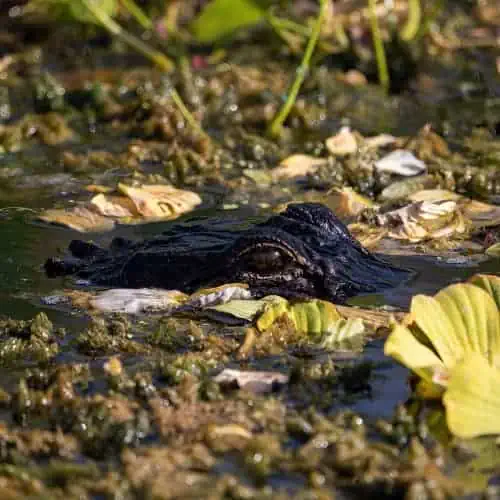
The American alligator is perhaps the most iconic animal in the Everglades and Florida as a whole. These reptiles average between 10 – 15 feet (3 – 4.6 meters) long and can weigh up to 1,000 pounds (450 kg). Their colors vary based on their environment: while often black, alligators may also come in shades of brown, gray, and even green. While they closely resemble crocodiles, the difference lies in their snouts. An alligator’s snout is wide and rounded, unlike a crocodile’s thin, triangular one.
Like crocodiles, however, alligators inhabit swamps and marshes. They especially prefer bodies of brackish water. Think of brackish water as ‘salty freshwater’ – with a saline level between saltwater and freshwater. While brackish water is plentiful in the Everglades, the American alligator population is concentrated in the park’s extreme south. As it remains relatively undeveloped, the southern Everglades provides plenty of food and shelter for these reptiles.
When insects, amphibians, and mammals grow scarce, it is not uncommon for larger alligators to prey on smaller ones. This cycle has allowed the American alligator to thrive as a native species to the region. As they have been in Florida as long as humans have, attacks are commonplace: the Florida Fish and Wildlife Conservation Commission (FWC) estimates several alligator attacks per year. The American alligator thus continues to be viewed with awe and caution – when not being overshadowed by its larger relative, the American crocodile.
2) American crocodile (Crocodylus acutus)

Averaging double the dimensions of an alligator, the American crocodile can grow up to 20 feet (6 meters) long and weigh as much as 2,000 pounds (910 kg). Though they are most often found in swamps and marshes, it is not uncommon for them to hunt in saltwater. While intimidating, they are less numerous than their alligator cousins. Look out for their pointy, triangular snouts along the Everglades coastline.
The American crocodile’s ability to thrive near saltwater allows for a highly varied diet. Ocean-dwelling fish, mollusks, and shellfish are common prey for juveniles and young crocs. Once mature, they develop the same tastes as average alligators. When hungry, large American crocodiles will consume just about any living or dead creature they encounter.
They are, fortunately, less aggressive than the saltwater crocodiles of Africa and Australia. Attacks in the United States are rare, but a crocodile attack outside the country is another story. While native to the Florida Everglades, the American crocodile is also found in Central and South America, where their reportedly larger populations may merit more aggressive behavior.
3) Eastern diamondback rattlesnake (Crotalus adamanteus)

Crocodilians could be the least of your worries if you consider the eastern diamondback rattlesnake. With adults averaging from 3 – 6 feet (1 – 2 meters) and 2 – 4 pounds (1 – 2 kg), this reptile is the most venomous snake in the United States. It gets its name from the diamond-shaped patterns along its back. Look for these distinct patterns along any brown, yellow, or black snake to know danger. More importantly, listen closely for the ‘rattling’ sound it makes when it is provoked or on the hunt.
Diamondbacks – as they are known – are often found within the Everglades’ flatwoods. Flatwoods are unique to the southeastern US and may consist of either piney woodlands or savannas. They provide ample prey and shelter for diamondback populations. During warm months, the snakes actively feed on small mammals and grounded birds. As the temperature drops, they sometimes nestle into the leftover burrows or nests of their prey.
The Everglades has an extensive range of flatwoods. Thus, the eastern diamondback can be found from north to south across the park. The ‘rattling’ sound produced by their tail, though distinct, is not often readily audible in the undergrowth. Consequently, diamondback attacks are not unheard of in Florida. Fortunately, their bites are rarely fatal in areas where antivenins are available.
4) Dusky pygmy rattlesnake (Sistrurus miliarius barbouri)
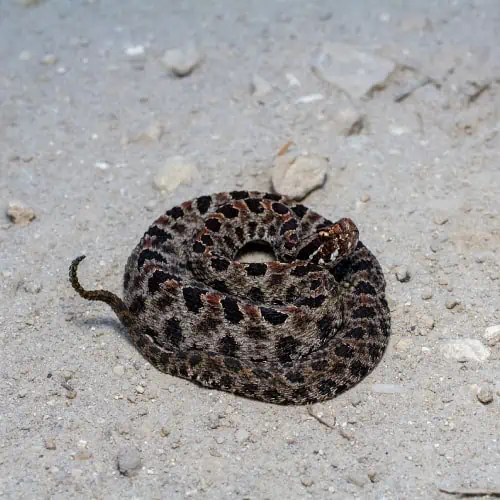
What if one were to drastically shrink the diamondback but retain the danger factor? The dusky pygmy rattlesnake is about a foot long and weighs just about a pound. Although it is the smallest and most common venomous snake in Florida, its highly dangerous venom is just as potent as a diamondback’s. Know the dusky pygmy by the distinct features along its thick, grey back: a bright, red stripe striking through a series of black, blotchy marks.
As the most common venomous snake in Florida, this snake can be found around and beyond the Everglades. When their native flatwoods degrade, dusky pygmies sometimes make new homes in suburban outskirts. But as they are small, they often prey on similarly-sized bugs and rodents. Still, their unnoticeable size and excellent camouflage result in several attacks per year. Be advised that children and small house pets are especially vulnerable to their venom.
5) Florida cottonmouth (Agkistrodon conanti)
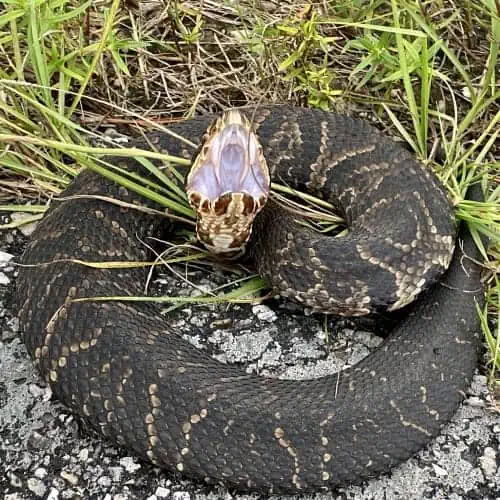
The sight of a snake in the water sends shivers down most people’s spines. The Florida cottonmouth – or water moccasin – is a strong swimmer. This semi-aquatic snake averages 2 – 4 feet (61 – 122 cm) and can weigh as much as 10 pounds (4.5 kg). This stealthy snake comes in shades of dark brown, olive-green, and even jet-black, but its mouth is evidently where it derives its common namesake.
Cottonmouths have a vividly pale mouth interior, reputedly as white as picked cotton. This feature is unique to their species. They inhabit wetlands dotted throughout the Everglades, where abundant bodies of water meet the requirements of their fish-and-amphibian diet. When lacking in waterborne prey, the Florida cottonmouth will choose to eat smaller, land-dwelling animals, if not other snakes.
Rarer than diamondbacks and pygmies, cottonmouths nonetheless pack a potent venom. Attacks by this snake on unaware or reckless individuals still occur. If you spot what may be a Florida cottonmouth, search for the dark stripes along their large, triangular heads. Waiting to see the brilliantly white mouth for verification may not be worth the risk.
6) Eastern coral snake (Micrurus fulvius)
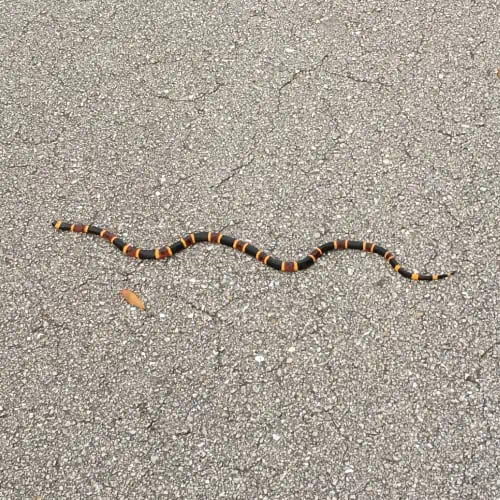
Vivid colors are sometimes nature’s way of saying ‘stay away’. The brilliantly-colored eastern coral snake, commonly referred to as the harlequin snake, is perhaps the easiest species to recognize on this list. Its unique, red body is marked with black-and-yellow bands. The snake’s colorful body belies an eerie truth – consider this old Floridian rhyme:
‘Red meets black, friend of Jack. Black meets yellow, deadly fellow.’
While there are other harmless snakes with red bodies and black bands, the Eastern coral snake alone bears the black-and-yellow pattern. To make matters worse, there is no widely available cure for its venom. In its preferred swamp and flatwood habitats, it is usually buried in foliage or vegetation. This species is an opportunistic one, preferring to wait and pounce on smaller reptiles.
Beautiful as it is, this venomous snake often chooses to flee from human interaction. Sightings are quite rare in the Everglades. Attacks are even rarer, yet still enough to make experts wary, as eastern coral snakes only bite as a last resort. Still, there is a reason the ominous nursery rhyme continues to be shared. A bite from the eastern coral snake is almost painless but can cause death within a few hours if left untreated.
7) Burmese python (Python molurus bivittatus)
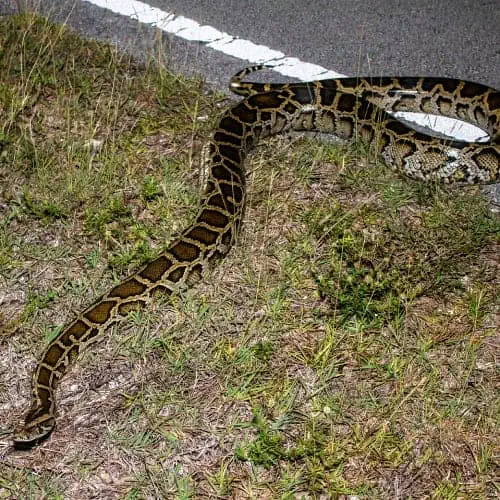
The non-venomous Burmese python has the potential to be the most dangerous animal in the Everglades. As an apex predator, this snake will constrict around and consume anything it comes across – not even alligators and crocodiles are safe! Though most adults average a length of about 6 feet (2 meters), some can grow to as long as 20 feet (6 meters) if left to their own devices. It is their status as an invasive species, however, that earns them notoriety.
As their name suggests, Burmese pythons are native to Burma and the East. Florida’s exotic pet industry has had – and continues to have – its share of irresponsible owners. Historically, pythons that escaped to the Everglades found themselves in the perfect habitat for steady consumption and reproduction.
Their voracious appetite and rapid breeding rate continue to harm the ecological harmony of the park and the state as a whole. Burmese pythons are invasive to the point that local governments encourage hunting them: python season is year-round – and a permit is not required. It has been an uphill battle to control this snake’s swelling population and its effect on the Everglades’ biodiversity.
8) Alligator snapping turtle (Macrochelys temminckii)

It is unusual to regard a turtle as dangerous, but one look at the alligator snapping turtle could change that perception entirely. Already large at an average of 2 feet (61 cm) and 100 pounds (45 kg), this living fossil has a spiked shell and a sharp-beaked mouth which add to its fierce, primordial appearance. Additionally, this ‘snapper’ is the largest of all extant freshwater turtles.
Comfortable in freshwater and brackish water, snappers are predominantly carnivorous. When motionless underwater, this turtle tricks fish and other amphibians into its mouth by dangling its bright-red, worm-like tongue. It is not uncommon for the occasional snapper to make its way into city canals, where its diet may consist of vermin and all sorts of curious pests.
While considered invasive in other parts of the world, alligator snapping turtles are native to North America. Sightings within the Everglades are quite rare – attacks, within and beyond the park, more so. Regardless, distance and proper handling are still advised. Snappers are more flexible than they look, and they can sink their beaks deep and hard into an unsuspecting victim with surprising quickness.
9) Widow spider (Latrodectus spp.)
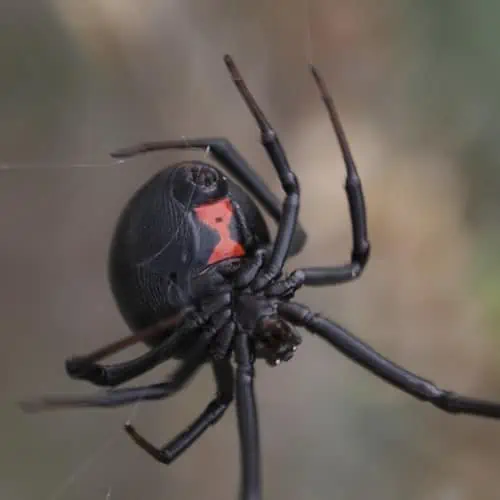
Although the red ‘hourglass’ on the back of a black widow is universally recognized as a sign of danger, poisonous widow spiders also come in different colors. The endangered red widow, for example, possesses bright, brown-and-red spots on its abdomen. Even rarer is the brown widow, with its unique, orange ‘hourglass’ pattern.
The widow spider’s namesake is earned from the female’s tendency to cannibalize the male when not preying on smaller crickets or cockroaches. As eerie as they are thought of, widow spiders are quite small: female widows clock in at just 8 – 15 millimeters (0.3 – 0.6 in) long. Male widows are even smaller at around 2 millimeters (0.1 in) on average. It’s no wonder why they are eventually feasted upon by females, as though their loss is of no consequence.
These spiders, while native to the US as a whole, thrive in the warm climates of the Southeast. Thus, one may find their subspecies anywhere in the Everglades – from under rocks in the wild to dark corners in swamp jetties. Their venomous bites can be remedied if immediate treatment is sought.
10) Brown recluse spider (Loxosceles reclusa)
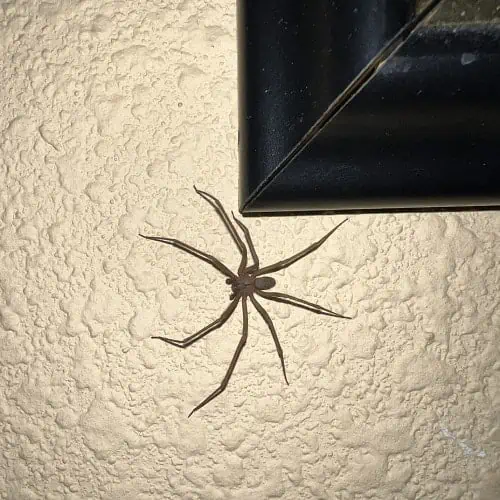
Despite their notoriety, widows are not the most dangerous spiders in the Everglades. The similarly-sized brown recluse spider poses a far greater risk: their bite merits a trip straight to the emergency room… or worse. But as their name suggests, the recluse is a timid species. It shares the same habitat and diet as the widow – save for the mate-cannibalizing aspect.
As all brown recluse subspecies are venomous, homeowners often kill similar-looking spiders out of fear. The Florida Department of Agriculture (FDAC) advises searching for the dark, ‘violin-shaped’ mark on a spider’s back to conclude whether a spider is of the brown recluse variant.
Antivenin for this creature is not widely available. While there have been reports of brown recluse populations in the southeastern regions of the Everglades, attacks and subsequent fatalities are more common in the spider’s native South America.
11) Florida black bear (Ursus americanus floridanus)

Do not feed the bears – especially the Florida black bear. Unique to the state, it is the only known bear capable of thriving in a subtropical climate. Smaller than most specimens at lengths of just 4 – 6 feet (1.2 – 1.8 meters), these bears can still consume enough to weigh as much as 600 pounds (272 kg)! Besides their dark coats, one can also point out their lack of a shoulder hump. Black bears have rounder backs, lacking the shoulder hump noticeable in the larger grizzly bears of the northern states.
Throughout Florida, these endangered mammals move from biome to biome in search of food. Within the Everglades, the largest concentration of black bears resides in the heavily forested areas of the park’s southern end. It is not uncommon to see one of these bears up in a tree, foraging or resting.
As omnivores, Florida black bears prefer plants but will sometimes scavenge carrion and even trash left behind by humans. Thus, they have developed a taste for garbage and may occasionally wander into the outskirts of suburban neighborhoods. These bears are usually docile and wary of humans, but authorities nevertheless advise people against luring them with food. Black bears that have grown accustomed to scavenging from trash cans have been known to attack humans that have gotten too close.
12) Feral hog (Sus scrofa)

Invasive feral hogs pose a danger to both Everglades National Park and Florida as a whole. Captive pigs become classified as feral when they manage to escape and survive in the wild. A bristly coat, enlarged tusks, and increased aggression are the hallmarks of a domestic hog gone feral.
Though they retain ordinary dimensions (5 – 6 feet, 100 – 200 pounds), these hogs tear up and destroy their surroundings in search of root crops. When no plants are to be found, a feral hog will not hesitate to maul smaller animals or consume leftover carrion. This wild diet leads to them becoming host to a series of diseases, such as itch-inducing pseudorabies and fever-causing brucellosis.
As an invasive species, feral hogs are found throughout the Everglades and beyond. They can become aggressive when cornered. Although local governments encourage hog hunting, caution is advised during an encounter. Experienced and amateur hunters alike have been injured by feral pigs.


I love Florida. Just keep in mind that the animals are trying to kill you and excercise caution and you will be ok. Lol. If you are thinking of moving here and dont want to deal with nature,then Forida may not be for you.